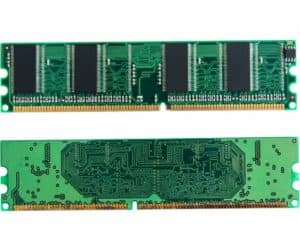In music production, RAM (Random Access Memory) is crucial for loading and running various elements, such as samples, plugins, and project files, in real-time. It serves as the temporary storage for data that the processor actively uses. Unlike storage drives (HDDs or SSDs), which store data permanently, RAM is volatile and is cleared when your machine is powered off.
For a majority of music producers, a RAM capacity of 16GB proves to be a sweet spot that balances performance and cost-effectiveness. This allows for smooth handling of moderately complex projects without breaking the bank. It also provides a buffer for multitasking and future software updates. However, producers who work on large-scale productions or utilize more resource-intensive plugins, will need 32GB or more. This provides ample headroom for handling extensive projects and complex virtual instrument setups without compromising performance.

Factors Influencing RAM Requirements
DAW Requirements
While every DAW has basic minimum requirements, they are not sufficient for optimal performance. These are just very basic specs that will let you run the program. As a general guideline, you need at least 8GB of RAM for basic production tasks. However, for anything worthwhile, you want to be in the 16 to 32GB range. It’s never a good idea to base your decision on minimum software requirements.
Genre / Type of Music Production
The RAM requirements for music production can vary based on the genre and complexity of your projects. If you’re producing electronic or rock music, 16GB of RAM is usually enough. However, if you’re working on massive orchestral stuff with lots of samples, or if you’re into symphonic or film music, it’s smarter to go for 32GB of RAM. Some folks even need 64GB or more for more complex virtual orchestrations.
But don’t worry, you can always freeze or bounce tracks to save memory. Just think about the kind of music you make and how big your projects get. The goal is to make sure your computer runs smoothly, so you can focus on making awesome music without any tech issues.
Size and Complexity of Projects
Larger projects with numerous tracks (200 – 250+), plugins, and intricate arrangements naturally demand more RAM. If you’re working on complex compositions or film scoring projects, where you need to handle extensive orchestral arrangements or utilize numerous virtual instruments simultaneously, a higher RAM capacity is essential to prevent system slowdowns. Even then 32GB is plenty for running various virtual instruments smoothly without any hiccups, mostly the ones that use samples. Just think about how much you’ll be doing at the same time and pick the RAM that fits your music-making style.
Sample Libraries, Virtual Instruments and Plug-ins
Sample libraries and virtual instruments are integral to modern music production. They can be resource-intensive, especially when dealing with high-quality, detailed samples. If you’re using sample bases like Kontakt instruments for cinematic or orchestral works, or plugins such as iZotope RX, you need to consider stepping up since loading these instruments into memory demands more RAM. For most people, a modern system equipped with virtual memory and efficient memory swapping, especially if paired with a solid-state drive (SSD), 32GB is likely more than sufficient. It’s a sweet spot that balances performance and practicality, without unnecessarily burdening your system.
Multitasking Requirements
Producers often engage in multitasking, running multiple applications alongside their DAW, such as video editing software, graphic design tools, or live performance software. The more applications you run concurrently, the higher the RAM requirement.
Loading multiple instances of virtual instruments or using large sample libraries simultaneously also places a significant strain on your system’s RAM. To accommodate such requirements, a higher RAM capacity becomes crucial. Always consider your multitasking habits when determining the ideal RAM capacity for your music production setup.
Future-Proofing Considerations
As technology advances and software becomes more sophisticated, future updates of your DAW and plugins may demand higher system requirements. Investing in a slightly higher RAM capacity than your current needs can be a strategic move to ensure your system remains capable of handling future updates and improvements in music production software.
Taking Budget into Account
While it’s tempting to go for the highest RAM capacity available, it’s essential to consider your budget. Assess your specific needs, and invest in the most RAM your budget allows. Keep in mind that other components, such as the CPU and storage, also contribute to overall system performance.
Final Words
To sum it all up, 16GB is often considered a sweet spot for many music producers, however, professionals working on extensive projects may find benefits in opting for 32GB or more. Ultimately, the key is to strike a balance between your specific needs, budget constraints, and the desire to future-proof your music production setup.
By carefully assessing these factors, you can ensure that your RAM capacity aligns with the demands of your creative process, allowing you to focus on what matters most – making great music.



